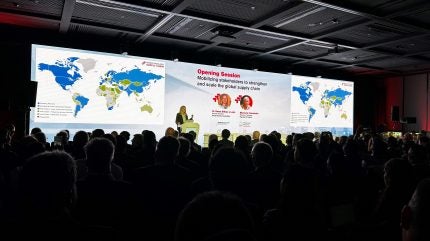
When Ontario Power Generation’s (OPG) senior vice-president for the Darlington New Nuclear Project, Jon Franke, took the stage during a panel at the 2025 World Nuclear Supply Chain (WNSC) Conference, he posed a simple question to the packed room: “Has anyone here been involved with a billion-dollar nuclear project that was delivered on time and according to plan?”
Not a single hand went up.

Discover B2B Marketing That Performs
Combine business intelligence and editorial excellence to reach engaged professionals across 36 leading media platforms.
“There we go,” he said, letting the silence speak for itself. It was a candid moment that underscored a truth long understood in the industry – the global nuclear industry needs a new playbook.
Over two days of discussions at WNSC, key stakeholders from the nuclear sector explored what this playbook should look like. The message was clear: meeting the goal of tripling nuclear capacity by 2050 will require a break from business as usual, starting with embracing long-term planning, greater standardisation and working together like never before.
Building confidence for the long haul
One of the strongest takeaways from this year’s conference was the urgent call for long-term thinking in both policies and practices within the industry.

US Tariffs are shifting - will you react or anticipate?
Don’t let policy changes catch you off guard. Stay proactive with real-time data and expert analysis.
By GlobalDataIndustry called on governments to provide clear and consistent market signals through policies that account for the long run. As Sama Bilbao y León, director general of the World Nuclear Association, put it: “We need to have stability in policies that can give us [the industry] long-term confidence, so we can all invest in our programmes.”
Her sentiment was echoed by EDF’s senior vice-president for international nuclear development, Vakisasai Ramany, who emphasised that “confidence in sustained demand for nuclear is most essential”.
This isn’t just about announcing one-off projects, Ramany pointed out, but “governments backing their nuclear ambitions with predictable policies, consistent funding mechanisms and stable regulatory frameworks”.
Carl Berglöf, national nuclear new-build coordinator in the Swedish Government, also highlighted the role of governments in “paving the way for nuclear by securing suitable, predictable regulations and financing schemes.” His beliefs were reinforced on Thursday – the day after the conference – with Sweden’s parliament taking a great leap forward by passing a pivotal bill outlining a financial aid model to fund new nuclear reactors.
For nuclear to succeed, this kind of governmental alignment is not optional – it is foundational.
Ramany added that “industry players, in turn, must be ready to commit and invest in building out capacity long-term”.
Marc Tannenbaum, principal technical executive at the Electric Power Research Institute (EPRI), agreed that planning ahead is beneficial.
“As we start looking at purchasing all this equipment for nuclear new builds, there is an opportunity to make sure that the information needed to support these facilities long-term is acquired during the construction process, when you’ve got the leverage associated with large spend,” Tannenbaum said, stressing that this will help “avoid spending millions of dollars later” trying to retroactively collect information that is needed to build maintenance and inventory programmes after the facility has opened.
Standardisation and simplification
Another clear theme of the conference was the need for standardisation across the entire supply chain. “We need to have streamlined and standardised regulation,” Bilbao y León said, arguing that it is not just a technical necessity, but a strategic enabler that helps unlock supply chain efficiency, lower costs and build trust among financiers.
“At the same time,” she noted, “we need to design our reactors in the most standardised and simplified manner”.
“Standardisation is important not only at the level of the design, but also in a broader sense,” added Andrei Goicea, policy director at NuclearEurope, pointing to a standardised, common supply chain and knowledge sharing.
For industry to take this step, “stop thinking about your success on an individual project”, Franke urged, “and recognise that a rising tide will raise all boats”.
He called on the industry to consolidate standards, collaborate on best practices and create a more open supply ecosystem to ultimately “bring costs down for the entire industry”.
When one of us wins, all of us win
The nuclear sector is shifting from siloed, state-led projects to a globally networked ecosystem. That was the consensus among the participants and speakers at WNSC, with PA Consulting Group’s business transformation leader, Connor Deehan, explaining: “Nuclear is now part of a very complex energy system. New applications – district heating, hydrogen, sustainable aviation fuel, and both on and off-grid electricity solutions – and new geographies turning to nuclear is driving a need for new thinking across industry, from typically state-driven deployment of projects to coordinated programmes involving a complex ecosystem of stakeholders: a mix of government, industry, grid technology providers, consumers and more all working together in a way that we haven’t really worked before under a more vertically integrated model.”
“It truly is an ecosystem that we are operating in,” Deehan said, “and collaboration is essential.” Ramany elaborated that this “means moving from isolated project announcements to clear investable pipelines”.
Bilbao y León summed up this new mindset: “We need to behave collectively as an industry and know that when one of us wins, all of us will eventually win.”
Introducing the concept of “glocalisation” – balancing global collaboration with local capability development – she added: “Yes, we need to develop local capabilities and supply chains, but we want to make sure that the entire global nuclear industry can make the most from the growth and economic opportunity from a nuclear power project, and not just one country, region or company capitalising on this opportunity alone.”
Ramany closed the circle by outlining what success should look like going forward: “Long-term infrastructure, deep technical expertise and a resilient, scalable supply chain… Now, to succeed, this global effort must be coordinated.”





